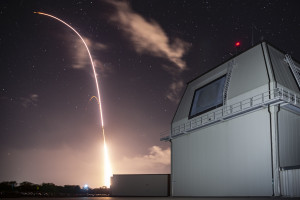The Senate Armed Services Committee’s draft FY 2021 defense authorization bill is fencing off half the funds the Missile Defense Agency (MDA) requested for a layered homeland missile defense system until it receives a detailed report.
The Defense Department’s FY ’21 budget request set out a plan to explore using the Aegis ballistic missile defense system with land-based Standard Missile-3 (SM-3) Block IIA interceptors and/or U.S. based Terminal High Altitude Area Defense (THAAD) batteries to provide a layered homeland missile defense system to augment the current California and Alaska-based Ground-based Midcourse Defense (GMD) system to target intercontinental ballistic missile (ICBM) threats.

MDA budget documents requested $39 million in research and development funds to assess if Aegis missile defense systems can be upgraded for the new mission and $139 million to start development and demonstration on a new interceptor prototype for a THAAD weapon system with a flight test planned for FY ’23.
The Senate bill provision directs the director of MDA to submit a report on this proposed layered homeland missile defense system by March 1, 2021. Until the report is submitted, the agency is restricted from using more than 50 percent of the FY ’21 funds directed for developing the new layered system.
The bill report explained while the committee supports DoD’s efforts to seek additional homeland missile defense coverage by the mid-2020s “the committee notes that the Department has provided very little information or analysis to support this proposal, despite including substantial funding within the MDA budget for this purpose.”
The bill language lists all of the required elements of the report. This includes a description of the approved requirements for a layered homeland missile defense system; an assessment of how much requirements addressed by a layered homeland missile defense system relate to those addressed by the existing GMD system including deployed Ground-Based Interceptors (GBIs) and planned upgrades to them; analysis of interceptor solutions to meet such requirements including land-based SM-3 IIA and THAAD systems with the number of locations required for deployment and production numbers of interceptors and related sensors; and the site-specific fielding plan including possible locations with the number and type of interceptors and radars in each location.
The report must also include relevant policy considerations for deploying the system to defend against ICBMs, cost estimate and schedule for options involving land-based MS-3 IIA and THAAD systems, a feasibility assessment of necessary modifications to THAAD for the new requirements, and an assessment of the industrial base capacity to support additional production of SM-3 IIA or THAAD interceptors.
The bill instructs the MDA director to consult with the Under Secretary of Defense for Policy, Under Secretary for Acquisition and Sustainment, Vice Chairman of the Joint Chiefs of Staff in his role as chair of the Joint Requirements Oversight Council, commander of Strategic Command, and commander of Northern Command.
Separately, the SASC recommends a provision to repeal the requirement for MDA to report to the Under Secretary of Defense for Research and Engineering. The bill report noted “the provision would not mandate an alternative organizational location for the MDA.”
These actions are in contrast to the House’s draft defense authorization bill. The House Armed Services Strategic Forces Subcommittee mark only recommends MDA develop the technologies to add a layered homeland missile defense system in the near to medium term (Defense Daily, June 24).